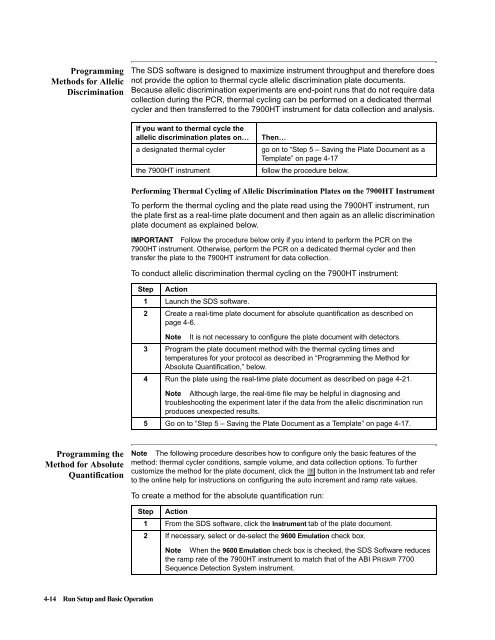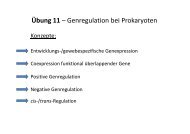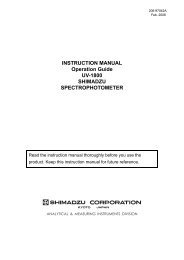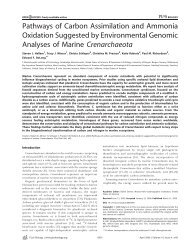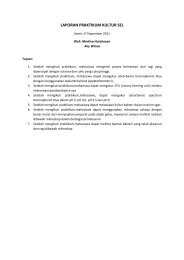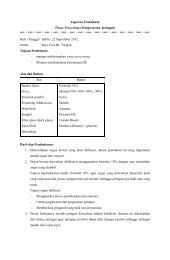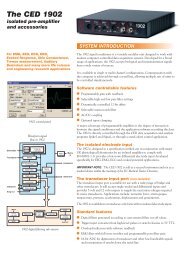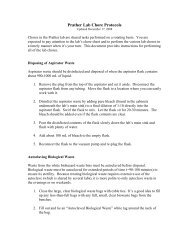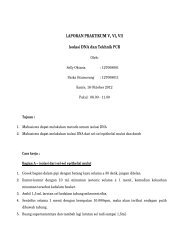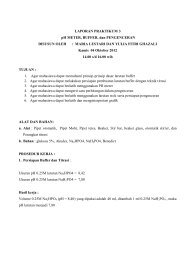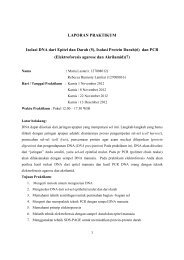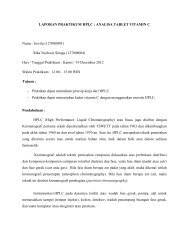ABI Prism® 7900HT Sequence Detection System ... - OpenWetWare
ABI Prism® 7900HT Sequence Detection System ... - OpenWetWare
ABI Prism® 7900HT Sequence Detection System ... - OpenWetWare
Create successful ePaper yourself
Turn your PDF publications into a flip-book with our unique Google optimized e-Paper software.
Programming<br />
Methods for Allelic<br />
Discrimination<br />
Programming the<br />
Method for Absolute<br />
Quantification<br />
4-14 Run Setup and Basic Operation<br />
The SDS software is designed to maximize instrument throughput and therefore does<br />
not provide the option to thermal cycle allelic discrimination plate documents.<br />
Because allelic discrimination experiments are end-point runs that do not require data<br />
collection during the PCR, thermal cycling can be performed on a dedicated thermal<br />
cycler and then transferred to the <strong>7900HT</strong> instrument for data collection and analysis.<br />
If you want to thermal cycle the<br />
allelic discrimination plates on… Then…<br />
a designated thermal cycler go on to “Step 5 – Saving the Plate Document as a<br />
Template” on page 4-17<br />
the <strong>7900HT</strong> instrument follow the procedure below.<br />
Performing Thermal Cycling of Allelic Discrimination Plates on the <strong>7900HT</strong> Instrument<br />
To perform the thermal cycling and the plate read using the <strong>7900HT</strong> instrument, run<br />
the plate first as a real-time plate document and then again as an allelic discrimination<br />
plate document as explained below.<br />
IMPORTANT Follow the procedure below only if you intend to perform the PCR on the<br />
<strong>7900HT</strong> instrument. Otherwise, perform the PCR on a dedicated thermal cycler and then<br />
transfer the plate to the <strong>7900HT</strong> instrument for data collection.<br />
To conduct allelic discrimination thermal cycling on the <strong>7900HT</strong> instrument:<br />
Step Action<br />
1 Launch the SDS software.<br />
2 Create a real-time plate document for absolute quantification as described on<br />
page 4-6.<br />
Note It is not necessary to configure the plate document with detectors.<br />
3 Program the plate document method with the thermal cycling times and<br />
temperatures for your protocol as described in “Programming the Method for<br />
Absolute Quantification,” below.<br />
4 Run the plate using the real-time plate document as described on page 4-21.<br />
Note Although large, the real-time file may be helpful in diagnosing and<br />
troubleshooting the experiment later if the data from the allelic discrimination run<br />
produces unexpected results.<br />
5 Go on to “Step 5 – Saving the Plate Document as a Template” on page 4-17.<br />
Note The following procedure describes how to configure only the basic features of the<br />
method: thermal cycler conditions, sample volume, and data collection options. To further<br />
customize the method for the plate document, click the button in the Instrument tab and refer<br />
to the online help for instructions on configuring the auto increment and ramp rate values.<br />
To create a method for the absolute quantification run:<br />
Step Action<br />
1 From the SDS software, click the Instrument tab of the plate document.<br />
2 If necessary, select or de-select the 9600 Emulation check box.<br />
Note When the 9600 Emulation check box is checked, the SDS Software reduces<br />
the ramp rate of the <strong>7900HT</strong> instrument to match that of the <strong>ABI</strong> PRISM® 7700<br />
<strong>Sequence</strong> <strong>Detection</strong> <strong>System</strong> instrument.


